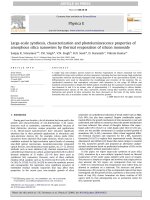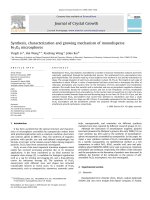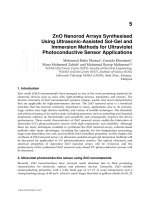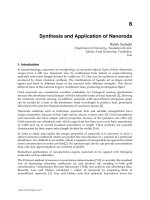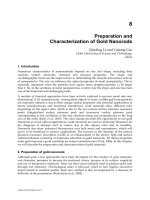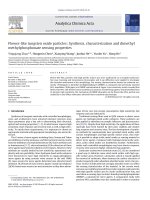Synthesis, characterization and fluorescence quenching of water soluble cationic conjugated polymers
Bạn đang xem bản rút gọn của tài liệu. Xem và tải ngay bản đầy đủ của tài liệu tại đây (2.19 MB, 272 trang )
SYNTHESIS, CHARACTERIZATION AND
FLUORESCENCE QUENCHING OF WATER-SOLUBLE
CATIONIC CONJUGATED POLYMERS
FAN QULI
NATIONAL UNIVERSITY OF SINGAPORE
2003
SYNTHESIS, CHARACTERIZATION AND
FLUORESCENCE QUENCHING OF WATER-SOLUBLE
CATIONIC CONJUGATED POLYMERS
FAN QULI
(MSc Nanjing Univ.)
A THESIS SUBMITTED FOR THE DEGREE OF
DOCTOR OF PHILOSOPHY
INSTITUTE OF MATERIAL RESEARCH AND
ENGINEERING (IMRE)
NATIONAL UNIVERSITY OF SINGAPORE
2003
Name: Fan Quli
Degree: Ph D of Philosophy
Dept: Institute of Material Research and Engineering (IMRE)
Thesis Title: SYNTHESIS, CHARACTERIZATION AND FLUORESCENCE
QUENCHING OF WATER-SOLUBLE CATIONIC CONJUGATED
POLYMERS
Abstract
Water-soluble conjugated polyelectrolytes have attracted increasing attention recently
due to their potential applications as high-sensitive fluorescent biosensors. However,
the influence of the physical and chemical properties of these WSCPs on the
quenching sensitivity is still a major concern that retards their application as biosensors.
The aim of this thesis was to syntheses and characterization of novel water-soluble
conjugated polyelectrolytes and to study the structure-quenching and
environment-quenching relationship of those conjugated polyelectrolytes as biosensors.
In all, many water-soluble cationic ammonium-functionalized
poly(p-phneylenevinylene) and poly(p-phenyleneethynylene) derivatives were
synthesized through Gilch and Wittig reaction and Heck reaction respectively, and
characterized by various modern techniques. The relationships of their optical
properties and quenching behaviors with molecular structures, polymer concentrations,
anionic saturated polymers and pH values were highly investigated and some modified
theories were proposed to explain those quenching behaviors.
Keywords: Water-soluble conjugated polymers, ammonium-functionalization,
sensors, poly(p-phneylenevinylene) (PPV), poly(p-phenyleneethynylene)
(PPE), fluorescence quenching.
I
ACKNOWLEDGEMENTS
My most sincere gratitude goes out to my supervisor, Dr Huang Wei, for his giving me
the opportunity to pursue a Ph. D degree at the Institute of Materials Research and
Engineering (IMRE). Also thanks him for his expert guidance, kind encouragement,
unselfish support and persistent creation of free research environment during the years.
Deepest appreciation goes to my co-supervisor, Assoc. Prof. Lai Yee Hing, for their
guidance despite their busy schedules.
I wish to give special thanks to Dr Pei Jian, Dr Chen Zhikuan, Dr Yu Wanglin and Dr
Liu Bin, who tried their best to afford me helpful discussions during my research.
Their consistent attitudes towards research were deeply impressed me and enlightened
me most. In addition, I want to thank all research staffs and students in the Polymeric
Light-Emitting Device Group at IMRE, Mdm. Xiao, Cheng Min, Ding Ailin, Liu
Xiaoling, Liu Shaoyong, Lu Su, Ni Jing, Pan Jingfang, and not forgetting Zeng Gang,
for their great help, collaboration and friendship. Especially, I must express my great
appreciate to Pan Jingfang and Lu Su, my best colleagues and friends who worked
with me together to spend that most difficult period.
I would also like to express my gratitude to the National University of Singapore for
the award of the research scholarship and IMRE for the top-up award and Department
of Chemistry for using the facilities to carry out my research.
Last but not least, I am very thankful to my parents and girlfriend Lu Xiaomei for their
warmest patience, encouragement and moral support during my study.
II
TABLE OF CONTENTS
ACKNOWLEDGEMENTS I
TABLE OF CONTENTS II
LIST OF TABLES IX
LIST OF SCHEMES X
LIST OF FIGURES XI
SUMMARY XVII
CHAPTER ONE 1
PART I: BACKGROUND 1
1.1.1 Conjugated Polymers 1
1.1.1.1 Structures of Conjugated Polymers 1
1.1.1.2 Applications of Conjugated Polymers 5
1.1.2 Light-Emitting Polymers (LEPs) and Devices (LEDs) 7
1.1.3 Conjugated Polymers Used as Chemo or Biosensors 12
1.1.4 Synthesis of PPV and Its Derivatives 17
1.1.4.1 Synthetic Routes for PPVs 17
1.1.4.2 Alkoxy-Substituted PPV Derivatives 20
1.1.4.3 Phenyl-Substituted PPV Derivatives 24
1.1.5 Synthesis of PPE and Its Derivatives 27
1.1.5.1 Synthetic Routes for PPEs 27
1.1.5.2 Alkoxy-Substituted PPE Derivatives 30
III
REFERENCES 35
CHAPTER ONE 47
PART II: INTRODUCTION 47
1.2.1 Conjugated Polyelectrolytes 47
1.2.1.1 Application of Conjugated Polyelectrolytes 47
1.2.1.2 Layer-by-Layer Self-Assembly of Conjugated Polyelectrolytes 48
1.2.1.3 Conjugated Polyelectrolytes Used as Chemo or Biosensors 53
1.2.2 Project Objectives 57
REFERENCES 62
CHAPTER TWO 68
SYNTHESIS, CHARACTERIZATION, AND FLUORESCENCE QUENCHING
OF NOVEL CATIONIC PHENYL-SUBSTITUTED
POLY(P-PHENYLENEVINYLENE)S 68
2.1 INTRODUCTION 68
2.2 MOLECULAR DESIGN 70
2.3 SYNTHESIS AND CHARACTERIZATION 71
2.3.1 Materials 71
2.3.2 Characterization Methods 72
2.4 RESULTS AND DISCUSSION 73
2.4.1 Synthesis of Monomers and polymers 73
2.4.2 Solubility Studies 76
IV
2.4.3
FT-IR Analysis 78
2.4.4 NMR Analysis 80
2.4.5 Thermal Stability 82
2.4.6 Optical Properties 83
2.4.7 Fluorescent Quenching of P3’ 88
2.5 CONCLUSIONS 92
REFERENCES AND NOTES 94
CHAPTER THREE 98
PART I: SYNTHESIS, CHARACTERIZATION AND OPTICAL PROPERTIES
OF CATIONIC PHENYL-SUBSTITUTED POLY(P-PHENYLENEVINYLENE)
RELATED COPOLYMERS 98
3.1.1 Introduction 98
3.1.2 Molecular Design 100
3.1.3 Materials and Characterization Methods 101
3.1.3.1 Materials 101
3.1.3.2 Characterization Methods 101
3.1.4 Results and Discussion 102
3.1.4.1 Synthesis of Monomers and Polymers 102
3.1.4.2 Color and Solubility 105
3.1.4.3 FT-IR Analysis 106
3.1.4.4 Gel Permeation Chromatography (GPC) 108
V
3.1.4.5
Thermal Stability 109
3.1.4.6 NMR Analysis 112
3.1.4.7 Optical Properties 114
3.1.5 Conclusions 117
REFERENCES AND NOTES 119
CHAPTER THREE 121
PART II: FLUORESCENCE QUENCHING OF CATIONIC
POLY(P-PHENYLENEVINYLENE)S WITH DIFFERENT CONTENTS OF
CIS-AND TRANS-VINYLIC LINKAGES 121
3.2.1 Introduction 121
3.2.2 Materials and Characterization Methods 123
3.2.2.1 Materials 123
3.2.2.2 Characterization Methods 124
3.2.3 Results and Discussion 124
3.2.4 Conclusions 136
REFERENCES AND NOTES 137
CHAPTER FOUR 139
PART I: SYNTHESIS, CHARACTERIZATION AND PH-SENSITIVE
OPTICAL PROPERTIES OF CATIONIC WATER-SOLUBLE
POLY(P-PHENYLENEETHYNYLENE)S 139
4.1.1 Introduction 139
VI
4.1.2
Molecular Design 141
4.1.3 Materials and Characterization Methods 142
4.1.3.1 Materials 142
4.1.3.2 Characterization Methods 142
4.1.4 Results and Discussion 143
4.1.4.1 Synthesis of Monomers and Polymers 143
4.1.4.2 Solubility and Color Study 145
4.1.4.3 NMR Spectroscopy 147
4.1.4.4 Thermal Stability 149
4.1.4.5 Optical Properties 150
4.1.4.6 pH-Sensitive Photoluminescence of P8’ 152
4.1.4.7 Stern-Volmer Study at Different pH Values 158
4.1.5 Conclusions 161
REFERENCES AND NOTES 163
CHAPTER FOUR 165
PART II: POLYMER-CONCENTRATION-DEPENDENT
PHOTOLUMINESCENCE QUENCHING OF
POLY(P-PHENYLENEETHYNYLENE) BY FE(CN)
6
4-
IN AQUEOUS
SOLUTION 165
4.2.1 Introduction 165
4.2.2 Materials and Characterization Methods 167
VII
4.2.2.1
Materials 167
4.2.2.2 Characterization Methods 167
4.2.3 Results and Discussion 168
4.2.3.1 UV-vis Absorption and Emission 168
4.2.3.2 Stern-Volmer Studies 170
4.2.4 Conclusions 178
REFERENCES AND NOTES 180
PART III: STUDY ON OPTICAL PROPERTIES AND FLUORESCENCE
QUENCHING OF CATIONIC WATER-SOLUBLE
POLY(P-PHENYLENEETHYNYLENE) UNDER COMPLEXATION WITH
ANIONIC SATURATED POLYELECTROLYTES 182
4.3.1 Introduction 182
4.3.2 Materials and Characterization Methods 183
4.3.2.1 Materials 183
4.3.2.2 Characterization Methods 184
4.3.3 Results and Discussion 184
4.3.3.1 UV-vis Absorption and Emission of Polyelectrolyte Complex 184
4.3.3.2 Stern-Volmer Study of PAANa/PPE-NEt
3
Br and
PMAANa/PPE-NEt
3
Br Complexes 190
4.3.4 Conclusions 196
REFERENCES AND NOTES 198
VIII
CHAPTER FIVE 200
EXPERIMENTAL SECTION 200
5.1 GENERAL 200
5.2 MONOMERS AND POLYMERS SYNTHESIZED IN CHAPTER 2 200
5.3 MONOMERS AND POLYMERS SYNTHESIZED IN CHAPTER 3 216
5.4 MONOMERS AND POLYMERS SYNTHESIZED IN CHAPTER 4 228
CHAPTER SIX 247
CONCLUSION REMARKS 247
IX
LIST OF TABLES
Table 1.1.1 Some common conjugated polymers _______________________________ 2
Table 2.1 GPC and Spectroscopic Data for Ph-PPVs __________________________ 86
Table 3.1.1 GPC and Spectroscopic Data for all Neutral and Quaternized Polymers 109
Table 3.2.1 Photoluminescence Quenching of Cationic PPVs by Fe(CN)
6
4-
________ 129
Table 4.1.1 Characterization of neutral polymers and uaternized polymers________ 147
Table 4.3.1 Photoluminescence quenching of complexes of PPE-NEt
3
+
and anionic
saturated polymers by Fe(CN)
6
4-
____________________________________ 192
X
LIST OF SCHEMES
Scheme 2.1 Synthetic Routes for Monomers 1 and 2 ___________________________ 74
Scheme 2.2 Synthetic Routes for Monomers 3 and 4 ___________________________ 75
Scheme 2.3 Synthetic Routes for the Polymers _______________________________ 76
Scheme 3.1.1 The synthetic routes for the monomers _________________________ 103
Scheme 3.1.2 The synthetic routes for those neutral and quaternized polymers ____ 104
Scheme 3.2.1 Chemical structure of neutral and quaternized PPVs used in our
investigation___________________________________________________ 123
Scheme 3.2.2 The conformation of one unit of P1’ and P2 _____________________ 134
Scheme 4.1.1 The synthetic route for monomers _____________________________ 144
Scheme 4.1.2 The synthetic routes for neutral and quaternized PPEs ____________ 145
Scheme 4.3.1 Chemical structures of ionic polymers used in our investigation _____ 183
XI
LIST OF FIGURES
Figure 1.1.1 The scheme for photoluminescence (PL) and electroluminescence (EL) of
conjugated polymers _______________________________________________ 9
Figure 1.1.2 The schematic diagram of the EL process__________________________ 9
Figure 1.1.3 The structure of a single-layer polymer LED device ________________ 10
Figure 1.1.4 Conjugated polymers used in PLEDs ____________________________ 11
Figure 1.1.5 Typical CPs used for detecting alkali or alkaline-earth metal ions _____ 13
Figure 1.1.6 Pyiridyl-based conjugated polymers as chemosensors_______________ 14
Figure 1.1.7 Band diagram illustrating the mechanism of quenching behavior for
conjugated polymers ______________________________________________ 15
Figure 1.1.8 A: The first reported molecular structure of conjugated polymer and
quencher used as fluorescence chemosensor. B: the structure of PPE derivatives
used for detecting TNT_____________________________________________ 17
Figure 1.1.9 The structure of PPV _________________________________________ 17
Figure 1.1.10 The reaction schemes for SPR, Gilch route and CPR. ______________ 18
Figure 1.1.11 The structure of MEH-PPV ___________________________________ 21
Figure 1.1.12 Some modifications of MEH-PPV______________________________ 22
Figure 1.1.13 Alkoxy-substituted PPV derivatives_____________________________ 23
Figure 1.1.14 Examples of some phenyl-substituted PPVs.______________________ 24
Figure 1.1.15 More examples of phenyl-substituted PPV derivatives ______________ 25
Figure 1.1.16 Some typical poly(aryleneethynylene)s (PAEs) ____________________ 28
XII
Figure 1.1.17 Palladium synthesis route ____________________________________ 29
Figure 1.1.18 The general synthetic route for dialkoxy-PPEs monomers___________ 32
Figure 1.1.19 The genernal synthetic route for dialkoxy-PPEs___________________ 32
Figure 1.2.1 The process of layer-by-layer adsorption _________________________ 49
Figure 1.2.2 Schematic representation of the structures of the polymer interlayers ___ 51
Figure 1.2.3 Diagram illustrating the detection mechanism of conjugated polyelectrolyte
for biomolecules__________________________________________________ 54
Figure 1.2.4 Diagrammatic representation for the use of a water-soluble CP with a
specific PNA-C* optical reporter probe to detect a complementary ssDNA
sequence. _______________________________________________________ 55
Figure 1.2.5 Molecular structure of WSCPs used as chemo or biosensors__________ 56
Figure 2.1 The designed neutral polymers for the green light emitting cationic polymers
_______________________________________________________________ 71
Figure 2.2 FT-IR spectra of the neutral and quaternized Ph-PPVs _______________ 79
Figure 2.3
1
H NMR spectra of the neutral and quaternized Ph-PPVs _____________ 81
Figure 2.4 Thermalgravimetric analysis of the neutral and quaternized Ph-PPVs ___ 82
Figure 2.5 UV-vis absorption and PL emission spectra of P1 in acetic acid CHCl
3
solution (1 M), in acetic acid aqueous solution (1 M) and as films___________ 83
Figure 2.6 UV-vis absorption and PL emission spectra of P2 and P3 in THF, P2’ and
P3’ in methanol and P3’ in water_____________________________________ 85
Figure 2.7 UV-vis absorption and PL emission spectra of P2, P3, P2’ and P3’ as films 87
Figure 2.8 Unmodified Stern-Volmer plot of P3’ (1.25
µ
M) quenched by Fe(CN)
6
4-
__ 89
XIII
Figure 2.9 Modified Stern-Volmer plot for the system in Figure 2.8 _______________ 90
Figure 2.10 UV-vis absorption and PL emission spectra of P3’ (1.25
µ
M) in the absence
and presence of Fe(CN)
6
4-
__________________________________________ 91
Figure 3.1.1 The designed neutral polymers for the cationic polymers ___________ 100
Figure 3.1.2 FT-IR spectra of the neutral PPVs _____________________________ 107
Figure 3.1.3 FT-IR spectra of the quaternized PPVs__________________________ 108
Figure 3.1.4 Thermalgravimetric analysis of the neutral and quaternized PPVs ____ 110
Figure 3.1.5 The DSC traces of P2 and P4-P6 in a nitrogen atmosphere__________ 111
Figure 3.1.6
1
H NMR spectra of the neutral polymers in chloroform-d ___________ 111
Figure 3.1.7
1
H NMR spectra of the quaternized polymers in methanol-d
4
________ 113
Figure 3.1.8 The UV-vis and PL spectra of the neutral polymers in CHCl
3
________ 114
Figure 3.1.9 The UV-vis and PL spectra of the quaternized polymers in CH
3
OH ___ 116
Figure 3.2.1 Absorption of Fe(CN)
6
4-
(10
µ
M) and emission spectra of P3’ (1.25
µ
M)
and P7’ (1.25
µ
M) in aqueous solution _______________________________ 125
Figure 3.2.2 Stern-Volmer plot of P3’ (1.25
µ
M) and P7’ (1.25
µ
M) quenched by
Fe(CN)
6
4-
in water _______________________________________________ 127
Figure 3.2.3 Modified Stern-Volmer plot of P3’ (1.25
µ
M) in Figure 3.2.2_________ 128
Figure 3.2.4 Stern-Volmer plot of P3’ (1.25
µ
M) by Fe(CN)
6
4-
in water and methanol 130
Figure 3.2.5 Stern-Volmer plot of quaternized polymer P3’ (1.25
µ
M) by Fe(CN)
6
4-
in
water and HCl aqueous solution (1 mM) and neutral polymer P3 (1.25
µ
M) in
CH
3
COOH aqueous solution (1 mM) ________________________________ 131
Figure 3.2.6 Stern-Volmer plot of P3 (1.25
µ
M) and P1 by Fe(CN)
6
4-
in CH
3
COOH
XIV
aqueous solution ________________________________________________ 133
Figure 3.2.7 Stern-Volmer plot of P3’, P5’ and P6’ by Fe(CN)
6
4-
in methanol ______ 135
Figure 4.1.1 The designed neutral polymers for cationic PPEs _________________ 141
Figure 4.1.2.
1
H NMR spectra of neutral polymers P8-P10 in CDCl
3
____________ 148
Figure 4.1.3
13
C NMR spectra of neutral polymers P8-P10 in CDCl
3
____________ 148
Figure 4.1.4
1
H NMR spectra of quaternized polymers P8’ in D
2
O and P9’-P10’ in
CD
3
OD________________________________________________________ 149
Figure 4.1.5 Thermalgravimetric analyses of the neutral and quaternized PPEs____ 150
Figure 4.1.6 UV-vis absorption and PL emission spectra of (a) neutral polymers P8-P10
in chloroform and (b) quaternized polymers P8’-P10’ in water or methanol __ 151
Figure 4.1.7 UV-vis absorption spectra of quaternized polymer P8’ in aqueous solution
with different pH values ___________________________________________ 152
Figure 4.1.8
1
H NMR spectra of (a) neutral polymer P8 in CD
3
COOD/D
2
O solution, (b)
quaternized polymer P8’ in D
2
O, (c) quaternized polymer P8’ in CD
3
COOD/D
2
O
solution and (d) quaternized polymer P8’ in D
2
O after addition of NaOH solution
and then neutralization by CH
3
COOH solution. ________________________ 153
Figure 4.1.9 PL emission spectra of quaternized polymer P8’ in aqueous solution with
different pH values _______________________________________________ 155
Figure 4.1.10 The curve of relative PL intensity of P8’ in aqueous solution versus pH
values which was adjusted by adding HCl and NaOH solution into P8’ solution at
pH = 7 respectively (
−•−
), adding HCl solution into P8’ solution at pH = 1
(realized through adding NaOH solution) (
), adding NaOH solution into P8’
XV
solution at pH = 13 (realized through adding HCl solution) (
∆
). Inset: the relative
PL intensity of P8’ at different pH environment after adding salt (sodium chloride)
with different concentrations at 10
-5
(
■
), 10
-4
(
▲
) and 10
-3
(
♦
)
µ
M respectively
______________________________________________________________ 157
Figure 4.1.11 The curve of relative PL intensity versus pH value at different P8’
concentration ___________________________________________________ 158
Figure 4.1.12 Stern-Volmer plot of P8’ (5
µ
M) quenched by Fe(CN)
6
4-
in aqueous
solution. Inset: the part of Stern-Volmer plot of P8’ (5
µ
M) quenched by Fe(CN)
6
4-
at low concentration _____________________________________________ 159
Figure 4.1.13 The plots of K
sv
value and relative PL intensity of P8’ (5
µ
M) versus pH
value__________________________________________________________ 160
Figure 4.1.14 The plots of K
sv
value of P8’ versus pH value at different P8’ concentration
______________________________________________________________ 161
Figure 4.2.1 UV-vis absorption and emission spectra of PPE-NEt
3
+
in aqueous solution
at different concentrations: [PPE-NEt
3
+
] = 1, 10 and 50
µ
M _____________ 168
Figure 4.2.2 UV-vis absorption and emission spectra of PPE-NEt
3
+
in water quenched
by added Fe(CN)
6
4-
. [PPE-NEt
3
+
] = 1
µ
M, [Fe(CN)
6
4-
] = 0, 0.0025, 0.025, 0.05,
0.1, 0.15, 0.20 and 0.25
µ
M; [PPE-NEt
3
+
] = 50
µ
M, [Fe(CN)
6
4-
] = 0, 0.125, 1.25,
2.5, 5, 7.5, 10 and 12.5
µ
M. Absorption spectrum red-shifted and fluorenscence
intensity decreased with increasing [Fe(CN)
6
4-
]. _______________________ 169
Figure 4.2.3 Stern-Volmer plots of PPE-NEt
3
+
at different concentrations quenched by
Fe(CN)
6
4-
. [PPE-NEt
3
+
] = 1
µ
M (
●
), 5
µ
M (
▲
), 10
µ
M (
▼
), 20
µ
M (♦) and 50
XVI
µ
M (
■
). Inset: low quencher concentration regime and linear static
Stern-Volmer fittings._____________________________________________ 171
Figure 4.2.4 The plot of the static quenching constant K
sv
S
versus the reciprocal of
[PPE-NEt
3
+
] ranging from 0.2 to 200
µ
M. ____________________________ 172
Figure 4.2.5 Fluorescence quenching of PPE-NEt
3
+
at different concentrations versus
[Fe(CN)
6
4-
].
[PPE-NEt
3
+
] = 1, 10 and 50
µ
M. The concentration of Fe(CN)
6
4-
ranges from 1/200 to 1/20 in units of the ratio of [Fe(CN)
6
4-
] to [PPE-NEt
3
+
] 177
Figure 4.3.1 UV-vis absorption and emission spectra of PPE-NEt
3
Br in the presence of
PAANa with different concentration__________________________________ 186
Figure 4.3.2 UV-vis absorption and emission spectra of PPE-NEt
3
Br in the presence of
PMAANa with different concentration________________________________ 188
Figure 4.3.3 Curves of relative fluorescence intensity (the intensity ratio of
PAANa/PPE-NEt
3
Br complexes to pure PPE-NEt
3
Br in aqueous solution) vs.
PAANa:PPE-NEt
3
Br or PMAANa:PPE-NEt
3
Br molar ratio_______________ 189
Figure 4.3.4 The Stern-Volmer plot of PAANa/PPE-NEt
3
Br (5 µM) complex quenched by
Fe(CN)
6
4-
in aqueous solution with different concentrations of PAANa ______ 190
Figure 4.3.5 The Stern-Volmer plot of PMAANa/PPE-NEt
3
Br (5µM) complex quenched
by Fe(CN)
6
4-
in aqueous solution with different concentrations of PMAANa __ 191
Figure 4.3.6 The K
sv
S
values of PPE-NEt
3
Br at different concentrations of those ionic
polymers, PAANa and PMAANa ____________________________________ 193
Figure 4.3.7 The percentage of inaccessible fluorophore vs the relative concentration of
PAANa and PMAANa_____________________________________________ 195
XVII
SUMMARY
The focus of this thesis was to syntheses and characterization of novel water-soluble
conjugated polyelectrolytes and to study the structure-quenching and
environment-quenching relationship of those conjugated polyelectrolytes as sensors.
The second chapter is focused on synthesis and characterization of a new series of
water-soluble green light-emitting poly(p-phenylenevinylene)s (PPVs). Novel
phenyl-substituted PPVs with tertiary amine functionality were prepared by using
either Gilch or Wittig reactions. Water-solubility was rendered to these materials via
post-quaterization on the neutral precursors. It was found that the content of
cis-/trans-vinylic group in the backbones depended on the polymerization method
employed and those corresponding polymers exhibited different optical properties and
fluorescence quenching.
The third chapter is divided into two parts. The first part is related to synthesis,
characterization and optical properties of cationic phenyl-substituted PPV related
copolymers. Such copolymers with thiophene, benzene and fluorene moieties showed
tunable electronic properties. Introducing fluorene unit into the main chain efficiently
enhanced the fluorescence intensity of conjugated polyelectrolyte. The second part is
focused on the quenching effects of Fe(CN)
6
4-
in water and methanol on cationic
phenyl-substituted PPV related copolymers with cis-/trans- vinylic group via Wittig
reaction and PPV homopolymers with entire trans-vinylic group prepared from Gilch
reaction. Compared with each other, it was demonstrated that the existence of
XVIII
cis-vinylic group in conjugated backbone indeed lower the quenching efficiency.
The fourth chapter is composed of three sections. The first section is referred to
synthesis, characterization and optical properties of cationic water-soluble
poly(p-phenyleneethynylene) (PPE-NEt
3
+
). The results showed obvious pH-dependent
fluorescence intensity and sensitivity of PPE-NEt
3
+
. The next section is about the study
on the fluorescence quenching of PPE-NEt
3
+
at different concentrations by Fe(CN)
6
4-
in aqueous solution. The static quenching constant K
sv
S
of PPE-NEt
3
+
increased with
the decrease of its concentration. To account for this phenomenon, the concept of local
quencher concentration was introduced into the Stern-Volmer equation and a new
equation which successfully presented the relationship between K
sv
S
and [PPE-NEt
3
+
]
was obtained. The third section is focused on optical properties and fluorescence
quenching of PPE-NEt
3
+
under complexation with anionic saturated polyelectrolytes. It
was showed that the complex structure was highly related to the structure of the
saturated polymer chosen. The quenching effects of those complexes were also
significantly determined by the structure of saturated polymer.
All these results prove that the new design and the strategy for novel water-soluble
conjugated polyelectrolytes had led to new materials which are very promising for
applications as biosensors and in theoretical study on corresponding quenching
behaviors.
Keywords: Water-soluble conjugated polymers, ammonium-functionalization,
sensors, poly(p-phneylenevinylene) (PPV), poly(p-phenyleneethynylene) (PPE),
fluorescence quenching.
1
CHAPTER ONE
Part I: Background
1.1.1 Conjugated Polymers
Since the discovery of highly conductive doped polyacetylene (PA) in 1977, The
investigation of highly conjugated organic polymers has been developed swiftly.
1
The
possession of good optoelectric properties made conjugated polymers excellent
alternatives with those widely used inorganic materials for constructing various
electrical devices. These polymers have low density, ease of fabrication, flexibility in
design and good stability, and their conductivity can be controlled by doping and by
modification the chemical structures. Using appropriate chemical and material
processes, the electronic, chemical and physical properties needed for a given device
can be controlled appropriately. During the past two decades, conjugated polymers
have become the focus of scientific research not only because of their theoretically
interesting properties but also because of their technologically promising future.
1.1.1.1 Structures of Conjugated Polymers
The term conjugated refers to organic macromolecules represented by alternating
double and single bonds, and is indicative of an σ-bonded C-C backbone with
π-electron delocalization. It is useful to define the extent over which the π-electrons are
delocalized as the conjugation length.
2
In fact, conjugated polymers are polymeric
semiconductors which combine the desirable processing characteristics inherent of
2
polymer systems with the sought-after electrical, electro-optic and non-linear optical
properties of semiconductors.
3,4
Table 1.1.1 Some common conjugated polymers
5
The semiconducting behaviour of conjugated polymers is easily understood from the
n
n
n
OR
RO
n
S
n
N
H
n
NH
n
n
RR'
S
S
n
S
R
S
R
n
Polymer Chemical Name Formula Bandgap
(ev)
PA trans-polyacetylene
1.5
PPP poly(p-phenylene)
3.0
PF polyfluorene
3.2
PPV poly(p-phenylene vinylene)
2.5
RO-PPV poly(2,5-dialkoxy-p-phenylene
vinylene)
2.2
PT polythiophene
2.0
P3AT poly(3-alkylthiophene)
2.0
PTV poly(2,5-thiophenylene
vinylene)
1.8
PPy polypyrrole
3.1
PANi polyaniline
3.2
3
bonding. The double or triple bonds between carbon atoms in the polymer chain each
have an electron excess to that normally required for bonding. These extra electrons
are in p
z
orbitals and are mainly perpendicular to the bonds between adjacent carbon
atoms. These electrons overlap with adjacent p
z
orbitals to form a delocalized
π-electron cloud that spreads over several atomic sites along the polymer backbone.
When this happens, delocalised π valence (bonding) and π* conduction (anti-bonding)
bands with defined bandgap are formed–the requirements for semiconducting
behaviour. Normally the electrons reside in the lower energy valence band but, if given
sufficient energy, they can be excited into the normally empty upper conduction band,
giving rise to a π–π* transition. Intermediate states are forbidden by quantum
mechanics. The delocalised π-electron system confers the semiconducting properties
on the polymer and gives it the ability to support positive and negative charge carriers
with relatively high mobilities along the chain.
6
However, a polymer must also satisfy two other conditions for it to work as a
semiconductor.
7
One is that the σ bonds should be much stronger than the π bonds so
that they can hold the molecule intact even when there are excited states – such as
electrons and holes–in the π bonds. These semiconductor excitations weaken the π
bonds and the molecule would split apart were it not for the σ bonds. The other
requirement is that π-orbitals on neighbouring polymer molecules should overlap with
each other so that electrons and holes can move in three dimensions between
molecules. Fortunately many polymers satisfy these three requirements. Most
conjugated polymers have semiconductor band gaps of 1.5–3 eV, which means that
4
they are ideal for optoelectronic devices which emit light.
Recently, different types of conjugated polymers (structure are showed in Table 1.1.1)
such as polyacteylene (PA), poly(p-phenylene) (PPP), poly(p-phenylenevinylene)
(PPV), polyaniline (PAni), polypyrrole (PPy) and polythiophene (PT) have been
developed and intensively investigated.
Poly(p-phenylene) and its derivatives (PPPs) have found considerable interest over the
past years since it acts as an excellent organic conductor upon doping whereas neutral
PPP is a good insulator. A second major interest arises from the fact that PPP can be
used as the active component in blue light-emitting diodes (LEDs).
8,9
Oligo(p-phenylene)s have played a dominant role as model compounds for PPPs in the
study of physical mechanisms related to intra- and inter-chain charge transport or
distribution and stabilization of charges and spins on π-conjugated chains. These
mechanisms are of special interest in regard to the potential application of PPPs in
rechargeable batteries.
10,11
PPV and its derivatives are among the most extensively
studied systems since the first reported light-emitting devices (LEDs) using PPV as the
emission layer.
12
The tremendous advantages in the chemistry and physics of PPVs
over recent years have stimulated further interest in related types of structures such as
poly(p-phenyleneethynylene) (PPE) polymers, which exhibit large photoluminescence
efficiencies both in solution and in the solid state as a consequent of their high degree
of rigidity, and their extremely stiff, linear backbones.
13
